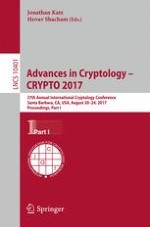The three volume-set, LNCS 10401, LNCS 10402, and LNCS 10403, constitutes the refereed proceedings of the 37th Annual International Cryptology Conference, CRYPTO 2017, held in Santa Barbara, CA, USA, in August 2017.
The 72 revised full papers presented were carefully reviewed and selected from 311 submissions. The papers are organized in the following topical sections: functional encryption; foundations; two-party computation; bitcoin; multiparty computation; award papers; obfuscation; conditional disclosure of secrets; OT and ORAM; quantum; hash functions; lattices; signatures; block ciphers; authenticated encryption; public-key encryption, stream ciphers, lattice crypto; leakage and subversion; symmetric-key crypto, and real-world crypto.
